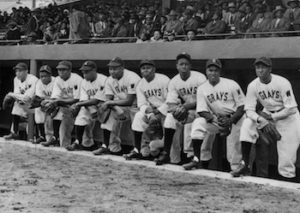
*This date in 1912 celebrates the founding of the Homestead Grays Baseball organization. They were among many Negro League teams in the early twentieth century.
They were located in Homestead, PA (near Pittsburgh). Over 30 Midwest, northeast, and South communities were home to these franchises organized into six leagues. In 1900, a young group of men who loved baseball joined to form the "Blue Ribbons" industrial league team. Unknowingly, these young men had found a team that would grow to be a Negro National League franchise and set unprecedented records. The Blue Ribbons remained mediocre for ten years, but they managed to field a team every year and play some of the best sandlot teams in the area.
In 1910, the team's managers retired. The players reorganized the team and named themselves the Murdock Grays. In 1912, they became the Homestead Grays. Drawing some of the largest crowds in the area, the team managed to win and have fun. From 1937 to 1945, they won nine straight league pennants.
They were led by future Hall of Famers Josh Gibson (C), "Cool" Papa Bell (OF), Judy Johnson (3B), Buck Leonard (1B), and Cuban great Martin Dihigo (2B, P, OF). Their ace pitcher was "Smokey" Joe Williams, who once struck out 27 batters in a 12-inning game. During World War II, the Grays played their home games at Forbes Field (Pittsburgh) and Griffith Stadium (Washington, D.C.) when white Major League clubs were on the road.
The Grays traditionally outdrew their white counterparts, the cellar-dwelling Washington Senators. Some of the players over the years included Vic Harris (OF), Jerry Benjamin (OF), Howard Easterling (3B), Luke Easter (OF, 1B), and Dan Bankhead. Bankhead became the first Black manager in Minor League Baseball in 1951. After the collapse of the Negro National League after the 1948 season, the Grays struggled to continue as an independent club but ultimately disbanded at the close of the 1950 season.